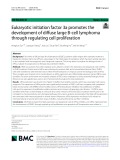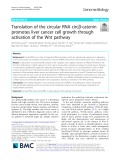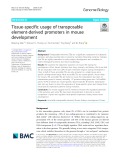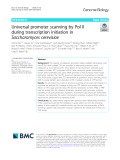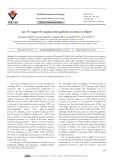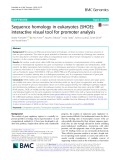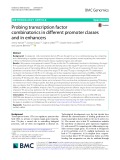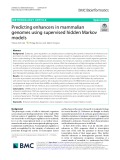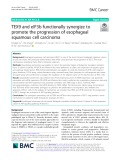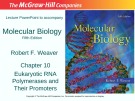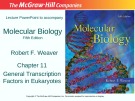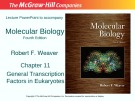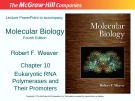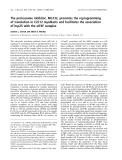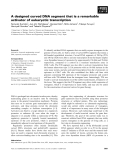
Eukaryotic promoters
-
One-third of diffuse large B-cell lymphoma (DLBCL) patients suffer relapse after standard treatment. Eukaryotic initiation factor 3a (eIF3a) is a key player in the initial stage of translation, which has been widely reported to be correlated with tumorigenesis and therapeutic response. This study aimed to explore the biological role of eIF3a, evaluate its prognostic and therapeutic potential in DLBCL.
 16p
16p  vishanshan
vishanshan
 27-06-2024
27-06-2024
 2
2
 1
1
 Download
Download
-
Ebook "Untranslated gene regions and other non-coding elements: Regulation of eukaryotic gene expression" pervasive transcription of complex genomes produces a variety of non-coding transcripts that interact with these regions and contribute to regulation. This book discusses recent insights into the regulatory roles of the untranslated gene regions and non-coding RNAs in the control of complex gene expression, as well as the implications of this in terms of organism complexity and evolution.
 63p
63p  manmanthanhla0201
manmanthanhla0201
 26-02-2024
26-02-2024
 5
5
 1
1
 Download
Download
-
As an adult tumor with the most invasion and the highest mortality rate, the inherent heterogeneity of glioblastoma (GBM) is the main factor that causes treatment failure. Therefore, it is important to have a deeper understanding of the pathology of GBM. Some studies have shown that Eukaryotic Initiation Factor 4A-3 (EIF4A3) can promote the growth of many people’s tumors, and the role of specific molecules in GBM remains unclear.
 12p
12p  visharma
visharma
 20-10-2023
20-10-2023
 2
2
 2
2
 Download
Download
-
Circular RNAs are a class of regulatory RNA transcripts, which are ubiquitously expressed in eukaryotes. In the current study, we evaluate the function of a novel circRNA derived from the β-catenin gene locus, circβ-catenin.
 12p
12p  vigalileogalilei
vigalileogalilei
 27-02-2022
27-02-2022
 5
5
 1
1
 Download
Download
-
Transposable elements (TEs) are a significant component of eukaryotic genomes and play essential roles in genome evolution. Mounting evidence indicates that TEs are highly transcribed in early embryo development and contribute to distinct biological functions and tissue morphology.
 25p
25p  viarchimedes
viarchimedes
 26-01-2022
26-01-2022
 6
6
 0
0
 Download
Download
-
The majority of eukaryotic promoters utilize multiple transcription start sites (TSSs). How multiple TSSs are specified at individual promoters across eukaryotes is not understood for most species. In Saccharomyces cerevisiae, a preinitiation complex (PIC) comprised of Pol II and conserved general transcription factors (GTFs) assembles and opens DNA upstream of TSSs.
 31p
31p  viarchimedes
viarchimedes
 26-01-2022
26-01-2022
 7
7
 0
0
 Download
Download
-
We investigated the effect of endoplasmic reticulum (ER) protein 29 (ERp29) on thyroglobulin (Tg) secretion and its negative regulation by microRNAs (miRNAs). ERp29 overexpression promoted Tg secretion from thyrocytes of PCCL3 cells via activation of ER stress sensors, including activation of transcription factor 6 fragmentation, XBP1 mRNA splicing by inositol-requiring enzyme 1, and phosphorylation of eukaryotic initiation factor 2 alpha as downstream actions of RNA-dependent protein kinase-like ER kinase.
 6p
6p  dolomite36
dolomite36
 30-12-2021
30-12-2021
 10
10
 0
0
 Download
Download
-
Microarray and DNA-sequencing based technologies continue to produce enormous amounts of data on gene expression. This data has great potential to illuminate our understanding of biology and medicine, but the data alone is of limited value without computational tools to allow human investigators to visualize and interpret it in the context of their problem of interest.
 11p
11p  vitzuyu2711
vitzuyu2711
 29-09-2021
29-09-2021
 10
10
 1
1
 Download
Download
-
In eukaryotic cells, transcription factors (TFs) are thought to act in a combinatorial way, by competing and collaborating to regulate common target genes. However, several questions remain regarding the conservation of these combinations among different gene classes, regulatory regions and cell types.
 19p
19p  vigiselle2711
vigiselle2711
 30-08-2021
30-08-2021
 6
6
 1
1
 Download
Download
-
Nuclear Factor Y (NF-Y) is a heterotrimeric complex composed of three unique subunits: NF-YA, NFYB, and NF-YC. The NF-Y transcription factor complex binds to the CCAAT box of eukaryotic promoters, playing a vital role in various biological processes in plants.
 15p
15p  visilicon2711
visilicon2711
 20-08-2021
20-08-2021
 24
24
 1
1
 Download
Download
-
The regulation of gene expression in eukaryotic cells is a complex process that involves epigenetic modifications and the interaction of DNA with multiple transcription factors. This process can be studied with unprecedented sensitivity using a combination of chromatin immunoprecipitation and next-generation DNA sequencing (ChIP-seq).
 7p
7p  vioklahoma2711
vioklahoma2711
 19-11-2020
19-11-2020
 11
11
 1
1
 Download
Download
-
Eukaryotic gene regulation is a complex process comprising the dynamic interaction of enhancers and promoters in order to activate gene expression. In recent years, research in regulatory genomics has contributed to a better understanding of the characteristics of promoter elements and for most sequenced model organism genomes there exist comprehensive and reliable promoter annotations.
 12p
12p  vicoachella2711
vicoachella2711
 27-10-2020
27-10-2020
 4
4
 0
0
 Download
Download
-
The 14-3-3 family is a group of intracellular proteins found in all eukaryotic organisms. Humans have seven isoforms that serve as scaffolds to promote interactions of regulatory phospho-proteins involved in many vital cellular processes and previous studies have shown that disturbances in native 14-3-3 levels can contribute significantly to the development of various cancers.
 10p
10p  vimoscow2711
vimoscow2711
 29-08-2020
29-08-2020
 8
8
 1
1
 Download
Download
-
Esophageal squamous cell carcinoma (ESCC) is one of the most frequent malignant digestive tumors around the world. We previously demonstrated that eIF3b could promote the progression of ESCC. The exact mechanisms underlying these effects remained unknown.
 9p
9p  vikuala271
vikuala271
 13-06-2020
13-06-2020
 7
7
 1
1
 Download
Download
-
In chapter 6 we learned that bacteria have only one RNA polymerase, which makes all three of the familiar RNA types: mRNA, rRNA, and tRNA. In this chapter we will see that three distinct RNA polymerases occur in the nuclei of eukaryotic cells. Each of these is responsible for transcribing a separate set of genes, and each recognizes a different kind of promoter.
 31p
31p  tangtuy05
tangtuy05
 30-03-2016
30-03-2016
 60
60
 2
2
 Download
Download
-
Chapter 11 - general transcription factors in eukaryotes. Eukaryotic RNA polymerases, unlike their bacterial counterparts, are incapable of binding by themselves to their respective promoters. Instead, they rely on proteins called transcription factors to show them the way. Such factors are grouped into two classes: general transcription factors and gene-specifi c transcription factors (activators). In this chapter we will survey the general transcription factors that interact with all three RNA polymerases and their promoters.
 38p
38p  tangtuy05
tangtuy05
 30-03-2016
30-03-2016
 78
78
 2
2
 Download
Download
-
Eukaryotic RNA polymerases, unlike their bacterial counterparts, are incapable of binding by themselves to their respective promoters. Instead, they rely on proteins called transcription factors to show them the way. Such factors are grouped into two classes: general transcription factors and gene-specifi c transcription factors (activators). In this chapter we will survey the general transcription factors that interact with all three RNA polymerases and their promoters.
 37p
37p  tangtuy02
tangtuy02
 08-03-2016
08-03-2016
 51
51
 2
2
 Download
Download
-
Chapter 10 - Eukaryotic RNA polymerases and their promoters. In Chapter 6 we learned that bacteria have only one RNA polymerase, which makes all three of the familiar RNA types: mRNA, rRNA, and tRNA. In this chapter we will see that three distinct RNA polymerases occur in the nuclei of eukaryotic cells. Each of these is responsible for transcribing a separate set of genes, and each recognizes a different kind of promoter.
 30p
30p  tangtuy02
tangtuy02
 08-03-2016
08-03-2016
 44
44
 1
1
 Download
Download
-
The eukaryotic translation initiation factor (eIF) 4E, is regulated by modulating both its phosphorylation and its availability to interact with the scaffold protein, eIF4G, to form the mature eIF4F complex. Here we show that treat-ment of C2C12 myoblasts with the proteasomal inhibitor, MG132 (N-carbobenzoxyl-Leu-Leu-leucinal), resulted in an early decrease inprotein synthesis rates followed by a partial recovery, reflecting the reprogramming of translation.
 16p
16p  dell39
dell39
 03-04-2013
03-04-2013
 41
41
 2
2
 Download
Download
-
To identify artificial DNA segments that can stably express transgenes in the genome of host cells, we built a series of curved DNA segments that mimic a left-handed superhelical structure. Curved DNA segments of 288 bp (T32) and 180 bp (T20) were able to activate transcription from the herpes simplex virus thymidine kinase (tk) promoter by approximately 150-fold and 70-fold, respectively, compared to a control in a transient transfection assay in COS-7 cells.
 12p
12p  inspiron33
inspiron33
 23-03-2013
23-03-2013
 41
41
 2
2
 Download
Download
CHỦ ĐỀ BẠN MUỐN TÌM








